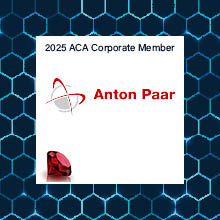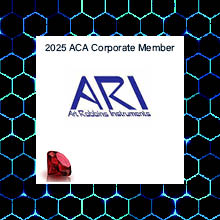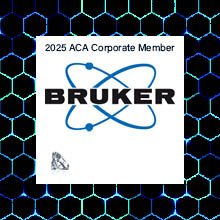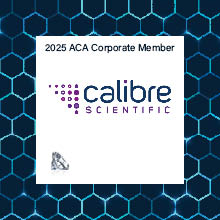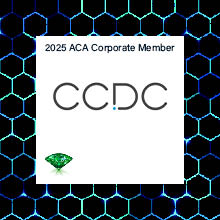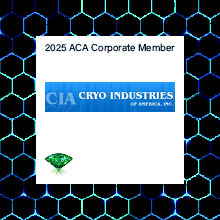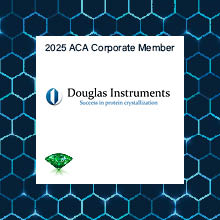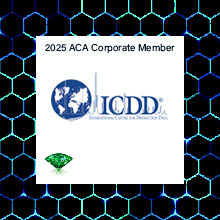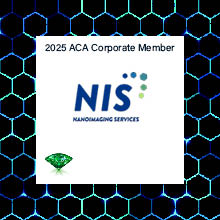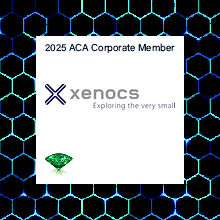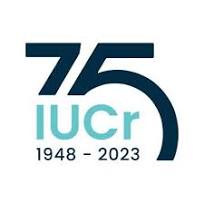2023 Meeting Statistics & Policies
In 2022 the ACA hosted the 73rd Annual Meeting in Baltimore, Maryland from July 7 - 11, 2023 for over 500 attendees from all over the world.
Venue
 |
|
Baltimore Marriott Waterfront
700 Aliceanna Street
Baltimore, Maryland 21202, United States
|
Meeting Committee
 |
 |
 |
 |
| Brandon Mercado |
Anna Gardberg |
Samantha Powell |
Stacey Smith |
Poster Chairs
 |
|
 |
| S. Andres |
|
L. Gallington |
Transactions
| |
ACA 2023 Transaction Symposium: |
From Atoms to Cells – Electron Microscopy for Structure Solution |
| |
Organizers: |
Jim Ciston [Molecular Foundry, Lawrence Berkeley National Laboratory]
Tamir Gonen [Howard Hughes Medical Institute, University of California, Los Angeles]
|
| |
Confirmed Speakers: |
Hong Zhou, Professor UCLA
Tim Grant, Assistant Professor, Morgridge Institute for Research
Matt Swulius, Assistant Professor Penn State.
Emma Danelius, Postdoctoral Fellow UCLA
Jihan Zhou, Assistant Professor Peking University
Julia Mundy, Assistant Professor Harvard University
Colin Ophus, Staff Scientist Berkeley National Lab
|
| |
Description: |
Structural determination in biology and materials science encompasses all resolutions, from atoms to entire organelles and cells. Knowledge of the three dimensional structure of biological materials, metals, materials and cells helps guide rational drug design and development, understanding of novel electronic materials, and understanding of the precise local structure of layered, disordered or amorphous materials. In this year’s Transactions symposium of the American Crystallographic Association we put together a fantastic lineup of top scientists working on all resolution scales and a multitude of technologies that are related.
In this symposium we will hear from experts and pioneers in the field of electron cryomicroscopy (cryoEM). Both applications and software for cryoEM will be highlighted as new technologies are developed and described by the experts. We will explore the uses of two other cryoEM methods, namely electron cryotomography (cryoET) of synapses and neuronal networks and microcrystal electron diffraction (MicroED) for drug discovery and the determination of novel structures. Finally, we will hear about applications of scanning electron microscopy and investigations of inorganic layered, disordered or amorphous materials by diffraction methods. We will also hear about the latest and greatest from experts involved in the development of data reduction software for X-ray crystallography and MicroED.
|
Awards
|
Yearly Awards
|
Margaret C. Etter Early Career Award: Kristin M. Hutchins (Texas Tech University)
A.L. Patterson Award: Tamir Gonen (UCLA)
Elizabeth A. Wood Science Writing Award: Juan Manuel García-Ruiz (CSIC-University of Granada)
For more information on awards and the criteria to nominate a candidate please see our Awards page.
|
|
Etter Student Lecturer Award Winners
|
Best Practices:
Abdullah Al Bashit
1.2.4: Small Angle Scattering To Characterize Structurally Complex Materials
Mapping of pathological inclusions in human brain tissue with Alzheimer’s disease
BioMac:
Evan Cramer
3.2.6: Structure of nucleic acid
Structure of a 10-23 Deoxyribozyme Captured in a Precatalytic State
Canada:
Nicholas Bragagnolo
4.2.2: The Future of Light Sources
Solution characterization of the dynamic conjugative entry exclusion protein TraG
CryoEM:
Ellen D Zhong
2.2.4: Machine learning in cryo-EM
Deep learning for reconstructing in situ structural landscapes from cryo-electron tomography
Industrial:
Ali Punjani
2.2.4: Machine learning in cryo-EM
3D Flexible Refinement: Determining Structure and Motion of Flexible Proteins from Cryo-EM
Light Sources:
Melissa Carrillo
2.2.5: Serial Crystallography
Micro-structured polymer fixed-targets (MISP-chips) for serial crystallography at synchrotrons
Materials Science:
Jacob Phillips
3.1.1: Total Scattering: Applications and advances in complex materials
Metal Oxygen Bond Anisotropy and Size Effects Scattering in V1-xMxO2 (M = Nb, Mo)
MicroED
Cody Gillman
4.2.5: Microcrystal Electron Diffraction of Proteins
Design and implementation of suspended drop crystallization
Neutron Scattering:
Tyger Salters
4.1.6: Magnetism, symmetry, and electronic correlations in topological materials and other quantum systems
Coupling of charge density wave to a spin cycloid in topological semimetal NdSbxTe2−x−δ
Powder Diffraction:
Lindsey Backman
2.1.5: DEI: expanding access & opportunities in structural science
A Snowball Effect of Opening Doors and Offering Sustained Support for Early Career Scientists
Service:
Sophie Anferov
2.2.1: Cool Structures II
Think, Pair, Share: Insight into Electronic Structure from Single Crystal Structures of Redox-Active Ligands
Small Angle Scattering:
Sarah J Shepherd
4.1.2: SAS in Vaccines and Drug Delivery Systems
Redefining the characterization paradigm of RNA lipid nanoparticles
Small Molecule:
Eslam E Elbakry
1.2.1: Exploring structure through complex modeling of multimodal experiments
Synthesis and Structural investigation of novel Barium Molybdenum Hollandite structures
Young Scientist:
Scott Lee
2.1.1: Cool Structures I
Redox-coupled structural distortions in quasi-1-dimentional Au2MP2
|
|
Poster Prize Winners
|
Linus Pauling Poster Prize(s)
Estella Yee: Structural characterization of a zinc-coordinated bis-histidine heme-binding site in the DUF2470 cyanobacterial protein
Feng Shi: Filament formation drives catalysis of glutaminase
Evan Billings: Structural basis and inhibition of outer membrane protein biogenesis in pathogenic Neisseria
Herman R. Branson Pauling Poster Prize
Laurel Kinmin: Building ground truth benchmarks of structural heterogeneity for cryo-EM
Muttaiya Sundaralingam Pauling Poster Prize
Jeyatharshika Antonyrajah: Structure determination of outer surface protein BBA57 from the Lyme disease pathogen support the structure-based design of needed therapeutics
Louis Delbaere Pauling Poser Prize
Shubha Gunaga: BICALUTAMIDE POLYMORPHISM: SOLID-STATE NMR CHARACTERIZATION OF TWO CRYSTALLINE FORMS
IUCr Pauling Poster Prize
Jieun Kim: Crystal structure of human interleukin-2 in complex with TCB2, a new antibody-drug candidate with antitumor activity
Journal on Structural Dynamics Poster Prize
Matt Mcleod: The temperature-dependent activity and structural changes of enzymes revealed using multi-temperature crystallography
RCSB Protein Data Bank Poster Prize
Alexander Paredes: Biophysical Characterization of the Pseudomonas aeruginosa BqsR/BqsS Two-Component System
CrystEngComm Poster Prize
Madeline Glennon: Structural Characterization of a Small Molecule-RNA Triple Helix Complex
Journal of Chemical Crystallography Poster Prize
So Young Bae: Mode of Substrate Binding for Ketohexokinase across Isozymes and Species Implies an Induced-Fit mechanism
Oxford Cryosystems Low Temperature Poster Prize
Meseret Haile: Dissecting M5717 killing of malaria parasites
MiTeGen-Society of Physics Students Undergraduate Poster Prize
Ammaar Saeed: Exploring the Interplay of Dynamics and Allosteric Regulation in PTP1B
Taylor & Francis Biomolecular Crystallography Poster Prize
Naba Krishna Das: The crystal structure of coxsackievirus 5′ RNA replication platform
|
| Press Releases |
The ACA collected almost 400 submitted abstracts and three were selected for press releases:
Killing Cancer in a Flash
A Head Start on the Next Pandemic
Insecticide-Resistant Mosquitoes Prompt New Look at Bed Nets
|
Workshops
Statistics
| ATTENDEES | In-Person Attendees | Abstracts | Oral | Posters |
|---|
|
545
|
375
|
287
|
88
|
ATTENDEE COUNTRY INFORMATION
|
|
|---|
|
Australia
|
1
|
|
Austria
|
1
|
|
Brazil
|
2
|
|
Canada
|
17
|
|
China
|
2
|
|
Czech Republic
|
1
|
|
France
|
2
|
|
Germany
|
5
|
|
India
|
2
|
|
Hungary
|
1
|
|
Japan
|
4
|
|
Korea, Republic of
|
8
|
|
Netherlands
|
1
|
|
Prefer Not to Disclose
|
57
|
|
Poland
|
3
|
|
Singapore
|
1
|
|
Spain
|
4
|
|
Sweden
|
1
|
|
Switzerland
|
4
|
|
United Kingdom
|
9
|
|
United States
|
419
|
| DEMOGRAPHICS | In-Person Attendees |
|---|
| Asian |
142 |
| Black or African Descent |
15 |
| Hispanic |
23 |
| White (Caucasian) |
296 |
| Other |
7 |
| Prefer not to Disclose |
40 |
| Did Not Disclose |
20 |
| DEMOGRAPHICS | In-Person Attendees |
|---|
| Male |
335 |
| Female |
170 |
| Non-Binary |
4 |
|
Prefer Not to Disclose
|
19 |
| Did Not Disclose |
15 |
Land Acknowledgment
We would like to acknowledge that ACA2023 will convene on the traditional ancestral lands of the Piscataway and the Susquehannock tribes.  We further wish to recognize that the original tribes have been merged through the northern migration by the Lumbee and the Cherokee. As we gather in Baltimore (and from places across the country and globe), we honor and recognize indigenous people of our homelands. We further wish to recognize that the original tribes have been merged through the northern migration by the Lumbee and the Cherokee. As we gather in Baltimore (and from places across the country and globe), we honor and recognize indigenous people of our homelands.
We recognize that Baltimore today is a community of many diverse Native peoples who continue to live and work here. We respectfully acknowledge and honor all Indigenous communities—past, present, future—and are grateful for their ongoing and vibrant presence.
We also acknowledge the systemic policies of genocide, relocation, and assimilation that still impact many Indigenous/Native American families today. As settlers and guests on these lands, we respect the work of Indigenous leaders and families and pledge to make ongoing efforts to recognize their knowledge, creativity, and resilience.
Conference Policy
The ACA recognizes the positive impact that a conference speaking opportunity has on an individual's track record and visibility. We also recognize that some sections of the scientific community are often under- represented in conference programs, and that this can affect diversity in the long-term. Our policies were developed to ensure quality and equality.
Speaker Invitation Policy
The program chairs will ensure the highest quality scientific program, with speakers that represent the broad diversity of our community. We aim to achieve a speaker and program chair balance that reflects the make-up of our community without bias with regard to gender identity or expression, sexual orientation, race, religion, geography, disabilities, or national origin.
Reporting Policy
We will report statistics on the conference website on the geographic and gender balance of invited speakers, selected speakers, session chairs, and attendees.
|







 We further wish to recognize that the original tribes have been merged through the northern migration by the Lumbee and the Cherokee. As we gather in Baltimore (and from places across the country and globe), we honor and recognize indigenous people of our homelands.
We further wish to recognize that the original tribes have been merged through the northern migration by the Lumbee and the Cherokee. As we gather in Baltimore (and from places across the country and globe), we honor and recognize indigenous people of our homelands.

